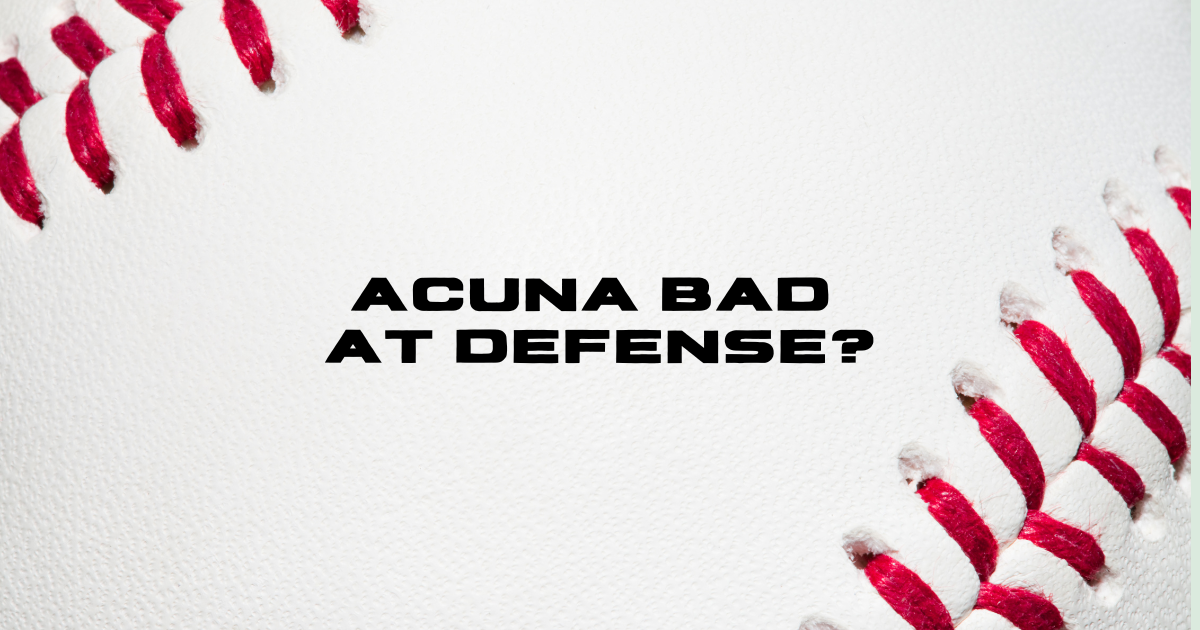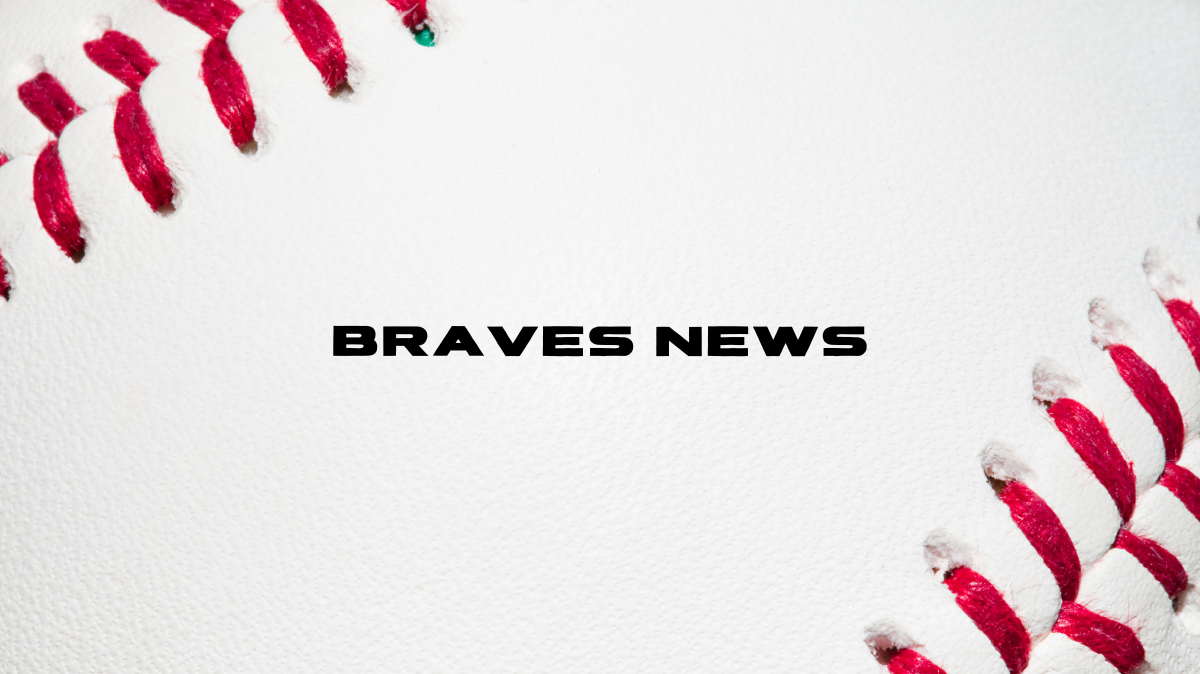Atlanta Braves Super-duper star Ronald Acuna Jr. is one of the front runners for NL MVP in 2023, but is he a liability on defense?
*Please note, there has been an update for 2024 added to a second page of this post. We will try and keep you up to speed on notable Acuna defensive plays on the second page throughout the 2024 season.
We won’t get into the stats behind the sizzling offensive start to the season Ronald Acuna Jr. is posting with a wooden bat in his hands, it’s been well chronicled, and if you are watching the Braves then you already know. Acuna has been must-watch TV at the plate and is probably on his way to an MVP Award.
The Stats Behind Acuna’s “Struggles” on Defense
Before we dive into what the metrics say about Acuna’s defense, here are a few explanations about some of these stats.
What does “defensive runs saved” mean? Defensive runs saved is a metric that attempts to decide how many runs better or worse a player is than the average Major Leaguer at his position. So, for example, if a player has three defensive runs saved at centerfield, that doesn’t mean he’s only saved three runs, it means he’s (an estimated) three runs better than the average MLB centerfielder. Three runs better is actually really good when you consider that Major-League caliber centerfielders are some of the best defensive players in the universe.
For a more detailed explanation and links to credible sources, check out our Guide to Advanced Defensive Analytics.
Why is Acuna’s Outs Above Average (OAA) Score so Bad?
While his speed and his arm remain elite, Acuna Jr. doesn’t have a good reaction time or get jumps like other right-fielders.
Outs Above Average
If you take a look at Ronald Acuna Jr.’s Baseball Savant page, you can see the two metrics that stick out like a sore thumb… does a sore thumb really stick in a conspicuous fashion? What is something that actually sticks out in a noticeable way? The two stats I’m referring to stick out like a sore finger with a giant booger on the end of it.
Acuna is red on everything but “Outfielder Jump” and “Outs Above Average.” These two stats are similar in nature as outs above average strictly assess the player’s ability to get to flyballs. Measuring how many flyballs a player gets to compared to other MLB outfielders is a part of the equation for other metrics like UZR and DRS, but Outs Above Average (OAA) isolates this ability.
The score is based on catch probability. Probability is figured based on the distance the player needs to travel to the ball and the time the ball was in the air. Outs Above Average measures infielders and outfielders differently.
Videos: Ronald Acuna Jr. Missing Balls With High Catch Probabilites
Below is an example of Acuna missing a 99% catch probability. If he were to catch this then he would get +.01 added to his score. If he misses this, he would get -0.99. This example is an unfortunate play but nonetheless, resulted in a -0.99 from Acuna’s score.
In the video below, Acuna loses an easy flyball from Vladimir Guerrero and suffers a huge dent in his defensive metrics since these are solely based on the hang time and distance needed to get to the ball. There is no free pass for losing it in the lights, in fact, there is a severe penalty.
Below is another video of Acuna Jr. missing on a ball that is caught by 99% of outfielders based on the distance needed and hangtime. According to the numbers, this ball would have been caught by 99% of outfielders. It appears Acuna was fooled by the spin on this line drive but it took him long enough to get a feel for where this ball was heading, it was worth -0.99.
Just based on distance needed to get to this ball and the amount of time it was in the air, 99% of the time it’s a catch. When you factor in real stuff like Acuna’s view, how hard this ball was hit, the spin it had on it, and a reasonable assumption that he wasn’t sure where it was going, it doesn’t seem egregious. He nearly caught the ball, but because he did not he was severely dinged for this play.
Below is a third ball that had a fairly high catch probability (55%) where Acuna chose to play it on the hop. There was nearly a 50/50 chance at getting to this ball and going for it could have resulted in extra bases. Without a great read off the bat, he didn’t have a chance and you could argue he played it smart but the metrics won’t listen.
Finally, I present to you Acuna missing a ball with a 70% catch probability. That means he had a .7 point deduction for this one. On the broadcast, it appears to be a solid effort (which it was) but relative to his peers, he got a bad jump. The slide as opposed to a dive probably didn’t help his cause considering how short his glove was of the ball.
According to the stats, Acuna Jr. is not getting good jumps and does not get to as many balls as other right-fielders. However, those four plays were worth -3.23 points. He would have to make four conversely improbable plays just to get back to zero at this point, and he’s not doing that.
As of this writing (07/01/23), Acuna Jr. ranks 86th among outfielders in OAA with -5. We found four plays that contributed a huge chunk of those negative points but he’s not making the improbable plays to bring his score back to zero. He makes a lot of plays he’s expected to make and that’s kind of it.
Ronald Acuna Catch Success Rate Chart Shows He Doesn’t Have Range or Make Improbable Catches
- 91-95% Catch Probability: 11/11 (100% Success Rate)
- 76-90% Catch Probability: 10/12 (83.3% Success Rate)
- 51-75% Catch Probability: 7/11 (63.6% Success Rate)
- 26-50% Catch Probability: 0/8 (0% Success Rate)
- 0-25% Catch Probability: 0/12 (0% Success Rate)
The list above provides more evidence that Acuna is not making the rangy more improbable plays he needs to boost his outs above average. Also keep in mind, the list above doesn’t even include the 96-99% probability plays and we highlighted two misses on those earlier!
His reads aren’t always the best, you might notice some circuitous routes on TV, and perhaps he just doesn’t want to risk blowing out his knee again.
*The data in the list above was pulled from Statcast’s Outfield Catch Probability Page.
Comparing Acuna’s Catch Success Rates to the Leaders
Luis Robert of the Chicago White Sox leads outfielders in OAA with a +9 score. He has caught 75% of his opportunities (0-95% probabilities) whereas Acuna has caught just 51.9% of his.
Of his four-star catches (26-50% probability) Robert has chased down 6/7 attempts compared to Acuna’s 0/8.
Robert even has one five-star catch (0-25% probability).
Add that to the fact that he is 31/31 on opportunities with a 76-95% probability and you get a the stats of a man who chases down some fly balls with the best of them. This is what Acuna doesn’t do.
Does This Mean Ronald Acuna Jr. is Bad at Defense?
Well, the metrics like OAA are not being very kind to Acuna, especially after those four plays we saw above. What does your eye tell you? Do those four plays sour your taste for having Acuna Jr. in right field as much looking at a negative OAA score?
What OAA Doesn’t Take into Account About Acuna’s Defense
Acuna is 21/23 on balls with a 76-95% catch probability. He has missed a handful of high probability catches and isn’t getting to the balls that really require some distance traveled. Does this mean he is a liability on defense? I certainly don’ think so and neither does Brian Snitker.
“Aw, don’t give me that,” Snitker says. “I’ve given up on those defensive numbers. I tell our analytics guys, ‘I don’t care.’ Really, I don’t care what they say. I know what I see. Ronnie is an elite defender. I watch him every night. He is a Gold Glove defender. That’s what the eye test tells me. That’s what I know.”
Braves Manager Brian Snitker on Ronald Acuna Jr.’s defensive metrics. –Sports Illustrated
Outs Above Average doesn’t factor in positional relativity like UZR or DRS. This means that Acuna is compared to all outfielders instead of just right fielders.
It also doesn’t take into account his cannon of an arm or his defensive positioning.
Ronald Acuna Jr. has the hardest recorded throw from the field in all of baseball this season at 104.1 mph. The next closest is Cody Bellinger’s 102.5 mph.
Ronald Acuna’s average velocity of 96.8 mph is the third-highest in baseball.
When you look at Defensive Runs Saved, Acuna’s numbers look good! Baseball Reference has him with five defensive runs saved and a pace of eight!
There really is no perfect statistic to evaluate how good a player is at defense. Would getting to a couple of low probability balls make Acuna leaps and bounds better at defense? No. In fact, could the effort sometimes cause balls to get past him to the fence? I don’t know if there is a metric that accounts for runs saved by playing it safe on a low probability ball.
Is Ronald Acuna Jr. Good at Defense?
We know that his arm terrifies third base coaches.
We know he makes most of the plays you would expect.
We know he’s great at making plays at the wall.
We know that Snit thinks Statcast can shove OAA up MLB’s Pipeline.
At the end of the day, we are talking about three or four low probability catches here and there and Acuna’s OAA changes by a lot. Sometimes playing a 50/50 ball safely can save your knee or save a run by not risking it. OAA highly rewards players for taking the big risk.
I take his score for what it is. I understand why it’s low but I agree with Snit. I don’t have any complaints and the overall defensive package that Acuna brings to the Braves’ right field is really good.
Share your thoughts in the comments. Do you think he sucks at defense? Is OAA a silly stat? Sound off!
Go to the next page to find the best and worst plays of Acuna’s 2024 season. We will periodically update this page with examples of certain plays and how they positively or negatively affected Acuna’s outs above average (OAA) or defensive runs saved (DRS).






Leave a Reply